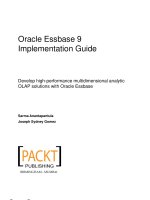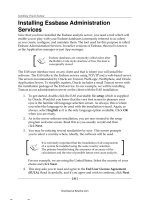Oracle Essbase 9 Implementation Guide- P18 potx
Bạn đang xem bản rút gọn của tài liệu. Xem và tải ngay bản đầy đủ của tài liệu tại đây (748.14 KB, 5 trang )
Building the Essbase Outline
[ 70 ]
Types of dimensions
In Essbase, there are two types of dimensions, the rst and most common dimension
type is the Standard dimension. The other less common dimension type is called an
Attribute dimension. Both are explained here.
Standard dimension
Standard dimensions are derived from the main business data components (or data
categories we described earlier) and are then dened in a database cube. Some of
the Standard dimensions in our example database are: TOTAL VEHICLES, MEASURES,
CALENDER PERIODS, TOTAL MODEL YEARS, CUSTOMERS, MARKET, and SCENARIO. These
dimensions can be tagged as Accounts, Time, and Country types. Some dimensions
are not associated with any type of special dimension types and are considered
general dimensions.
Briey, let's explore the different ways you can tag a Standard dimension and
their uses.
The Account dimension type
When you tag a dimension as an Account type, you are telling Essbase that this
dimension will be used for your nancial measures or metrics.
Available to the
Account dimension are several accounting specic tags such as
the Time Balance option that uses the Time dimension to calculate period specic
data or the Two Pass Calculation option which will calculate the data in two
passes when components of that data must be calculated rst from the existing data.
The Time dimension type
The Time dimension type is the dimension where you dene the periods used to
calculate and report your data. This would typically be the dimension where you
store calendar periods. The Time dimension also supports several of the Accounts
dimension functions.
The Country dimension type
A dimension tagged as a Country dimension allows you to analyze your data across
multiple countries, if you desire. You can also set the currency for each country to get
true and current nancial data analysis for each local market dened in your database.
This material is copyright and is licensed for the sole use by Paul Corcorran on 5th July 2009
8601 ave. p #1, , lubbock, , 79423
Download at Boykma.Com
Chapter 3
[ 71 ]
No dimension type or general dimension
Not all dimensions need to have a specic identier tag. You can always create
a general dimension that you can use for any variety of data descriptor purposes.
Most of your dimensions will be general dimensions.
The Currency Partition dimension type
This type of dimension is used for currency conversion in your database.
The database would contain all nancial data represented in a base currency.
The Currency Partition dimension is used to allow local currencies from
other regions to be brought in from a separate Essbase database.
The
Currency Partition dimension is specically designed for currency
conversion applications and is not always necessary to achieve your desired
results. Careful preparatory investigation upfront is always recommended.
Below is a sample screenshot showing an outline containing dimensions that
are tagged with the various available dimension types. Once the dimensions are
properly set, you will see the dimension type listed in the database outline next
to the dimension name.
The specic dimension tags are for convenience and enhanced functionality. However,
many of these options were not available in earlier versions of Essbase so you would
have needed to code your own functionality.
This material is copyright and is licensed for the sole use by Paul Corcorran on 5th July 2009
8601 ave. p #1, , lubbock, , 79423
Download at Boykma.Com
Building the Essbase Outline
[ 72 ]
The Attribute dimension
There is a dimension type known as an Attribute dimension type. The Attribute
dimension is not a full blown standard dimension and in fact must be associated
with a standard dimension. The Attribute dimension allows you to analyze your
data with even ner granularity by adding data characteristics (for example, color)
to your Total Vehicle dimension.
If it is not an Attribute dimension type then it is
some form of Standard dimension.
Dense and Sparse dimensions
As we described before, the data stored in an Essbase database is stored in a manner
conceptually similar to that of a Rubik's Cube. Because of this structure, the folks at
Oracle have devised a method of dening your outline dimensions and their data
density to Essbase. Therefore, your database can be more efcient in the way it loads,
stores, calculates, and retrieves your data.
The distinction between Dense and Sparse dimensions allows Essbase to efciently
handle large amounts of data that is not evenly spread across the data blocks. It
is this efciency that allows Essbase to offer the slice and dice style of data access,
while still maintaining high performance for fast data processing and retrievals.
Correctly set Dense and Sparse dimension attributes have a
dramatic effect on overall memory usage and system performance!
• In a Sparse dimension, the data does not exist for the better
part of the member combinations. For example, all vehicles
may not be sold in all of the countries
• A Dense dimension has a very high percentage of available
data cells lled with data.
First of all, you will need to consider whether a database dimension is Dense
or Sparse in an Application|Database that has been created using the BSO. All
dimensions in an ASO database are Sparse by default. When you have an Essbase
database created using the BSO, Essbase allows you to describe your dimensions as
either Dense or Sparse with the following understanding. Some data cubes, created
roughly by dimension, are not fully populated with data. In fact, for the most part,
the typical Essbase multidimensional database's cube always has a relatively Sparse
concentration of data at the overall database level. It would be an extreme rarity to
nd your data densely populating every available cell with a stored value.
This material is copyright and is licensed for the sole use by Paul Corcorran on 5th July 2009
8601 ave. p #1, , lubbock, , 79423
Download at Boykma.Com
Chapter 3
[ 73 ]
When you rst start out, you can let Essbase automatically congure the Dense
and Sparse dimension settings in your database. You do this using the EAS Outline
Properties tab. Essbase will do this fairly well initially, based on the data already
existing in the database.
Notice in the preceding screenshot that there is an Auto congure option on the
outline properties screen. If set to true, this option will let Essbase automatically
set the Dense/Sparse settings of the dimensions in your database.
As time goes on and as both your knowledge of your system's data grows and your
experience with Essbase increases, you will nd that you can usually do a better job
of conguring the Dense and Sparse settings yourself rather than let Essbase handle it.
You can, at any time, change the Dense and Sparse attribute of any dimension.
You will do this using the EAS at the database properties screen.
One of the best features of Essbase is the outline or database restructure. Anytime
you make a change to the database outline, you are offered the choice of saving the
changes when you attempt to close the outline. The restructure choices available are
Outline Only and Outline and Data.
This material is copyright and is licensed for the sole use by Paul Corcorran on 5th July 2009
8601 ave. p #1, , lubbock, , 79423
Download at Boykma.Com
Building the Essbase Outline
[ 74 ]
When you make changes to your database outline, the changes may also affect the
way the data itself is stored. Changes such as moving a member or changing a Dense
setting to a Sparse setting will always require you to perform an Outline and Data
restructure. When the restructure is called for, Essbase will actually perform what
could be best compared to in the relational world as database reorganization. All of
the existing data is unloaded and then reloaded into a structure that is most efcient
for the new database outline conguration and settings.
When Essbase is performing an Outline Only database restructure, the database
page les are not touched as only the database outline le is reorganized and resaved.
An Outline Only restructure is triggered by making simple changes to the database,
including adding or updating an alias table or adding or updating a member property.
When Essbase deems it necessary to restructure the entire database, it will completely
rebuild the database's page and index les. This type of database restructure is
sometimes referred to as a Dense restructure. What triggers a Dense restructure is
actually moving around the members in the database outline, adding new members
to the outline, or changing the Dense and Sparse setting on a dimension.
Very Important
When performing a database restructure, Essbase actually rebuilds
new temporary database page les from the existing page les. When
nished, Essbase will delete the old page les and rename the new ones.
Prior to any database restructure always make sure you have extra
storage on your server. If the database you are restructuring is 30GB and
you only have 20GB of space available Essbase will keep on going with
the restructure until the disc space runs out and crashes the server!
VEHICLES
M
A
R
K
E
T
S
CALENDAR
PERIODS
This material is copyright and is licensed for the sole use by Paul Corcorran on 5th July 2009
8601 ave. p #1, , lubbock, , 79423
Download at Boykma.Com









